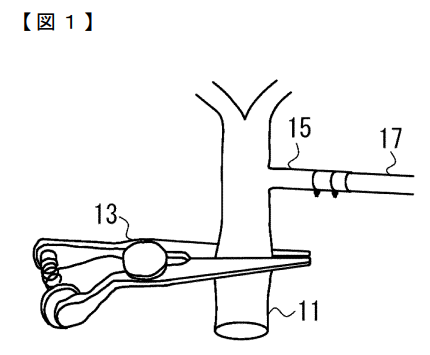
- Overview of the Patent Drawing
- Patent Insight 1: Clamp Design Tailored for Veterinary Surgery
- Patent Insight 2: Facilitating Complex Procedures with Auxiliary Pathways
- Patent Insight 3: Potential Integration with Specialized Veterinary Tools
- Patent Attorney’s Thoughts
- Keywords
- Application of the Technology: “Ultra-Precise Plush Toy Repair System for Sentimental Emergencies”
Overview of the Patent Drawing
The illustration depicts a clamp device (13) used in surgical procedures for non-human animals, designed to occlude or restrict the flow in a blood vessel or tube (11). The clamp is applied to the vessel to control bleeding or fluid flow during surgery. Additionally, a smaller branch (15) extends from the main vessel, possibly representing an auxiliary blood vessel or a catheter (17) for medical intervention.
Patent Insight 1: Clamp Design Tailored for Veterinary Surgery
The use of the clamp (13) with a spring-loaded mechanism is particularly suitable for veterinary applications, where controlling blood flow in non-human animals can be challenging due to differences in anatomy and vessel size. The design allows for quick and secure application during various types of animal surgeries, such as spaying, neutering, or emergency procedures.
Patent Insight 2: Facilitating Complex Procedures with Auxiliary Pathways
The illustration suggests that the clamp can be used to control not only the main blood vessel (11) but also auxiliary pathways (15, 17). This can be beneficial in complex surgeries involving multiple vessels or when using catheters to administer fluids or medications. The versatility of the clamp makes it a valuable tool for managing different surgical scenarios in veterinary practices.
Patent Insight 3: Potential Integration with Specialized Veterinary Tools
The clamp could be integrated with other specialized tools used in veterinary surgery, such as monitoring equipment for measuring blood pressure or flow. Incorporating such features could enhance the precision of the surgical procedure and improve outcomes by providing real-time feedback on the status of the occluded vessel.
Patent Attorney’s Thoughts
Upon reviewing the patent drawing for the “Surgical Method for Non-Human Animals Using a Clamp Device,” I am impressed by the thoughtful design tailored to the unique challenges of veterinary surgery.
The clamp’s spring-loaded mechanism appears to offer precise control over blood flow, which is crucial when dealing with the diverse anatomies of different animal species.
The inclusion of auxiliary pathways in the design suggests a versatility that could accommodate complex procedures, such as those requiring simultaneous management of multiple vessels or the integration of catheters.
This adaptability is particularly valuable in veterinary settings, where surgical scenarios can vary widely.
Furthermore, the potential for integrating this clamp with specialized veterinary tools, like monitoring equipment, indicates a forward-thinking approach that prioritizes both efficacy and safety.
By providing real-time feedback during procedures, such integration could enhance surgical outcomes and animal welfare.
Overall, this patent exemplifies how innovative design can address specific needs in veterinary medicine, offering tools that are both functional and considerate of the patients’ well-being.
Keywords
veterinary surgery, non-human animals, clamp device, blood vessel occlusion, spring-loaded clamp, animal surgery, auxiliary pathway
Application of the Technology: “Ultra-Precise Plush Toy Repair System for Sentimental Emergencies”
Purpose
By repurposing the surgical clamp method for non-human animals, develop an “Ultra-Precise Plush Toy Repair System” aimed at performing delicate, emotionally significant “surgeries” on beloved stuffed animals. This system mimics veterinary surgery for plush patients, offering therapeutic benefits to children and nostalgic adults alike.
System Components
- Micro-Clamp Assembly Unit: A scaled-down, plush-friendly version of the surgical clamp, designed to gently hold soft fabric and stuffing without causing damage or unraveling.
- Stuffed Tissue Stabilization Pad: A soft, non-slip mat with adjustable contours that supports the plush animal during “surgery,” ensuring it remains still and dignified throughout the process.
- Sentiment-Preserving Suture Kit: Special thread and needles tailored for various plush fabrics (minky, fleece, velveteen), allowing for high-precision stitching of emotional wounds.
- Pre-Op Emotion Assessment Chart: A checklist where users (especially children) specify the plush’s symptoms:
“He’s sad because I dropped him in spaghetti.”
“She lost her tail in a tragic couch accident.”
“I hugged him too hard during math homework.” - Post-Op Certificate of Recovery: Upon completion, the system prints an official certificate declaring the plush “restored to full cuddle function,” complete with paw print and smiley-face stamp.
Operational Flow
- Check-In & Diagnosis: The user presents the plush animal and completes the emotion assessment chart, giving the repair crew a full history of the “trauma.”
- Stabilization & Clamp Application: The plush is gently placed on the stabilization pad. Micro-clamps hold torn limbs, ears, or tails in precise position for repair.
- Emotional Micro-Surgery: A trained “plush surgeon” uses the suture kit to perform delicate stitching. For dramatic effect, a small surgical lamp and ambient music may be employed.
- Post-Op & Recovery: After the procedure, the plush rests on a mini recovery bed while the owner is given tea and tissues (just in case).
- Discharge & Celebration: A recovery certificate is presented. The owner reunites with the plush patient, now “better than new but still smells like home.”
This is not about fixing a toy. It’s about suturing memory, dignity, and love—one plush limb at a time.
Disclaimer: This content is an AI-generated reinterpretation based on a patent drawing.
It is provided for educational and cultural purposes only, and not as legal advice.



